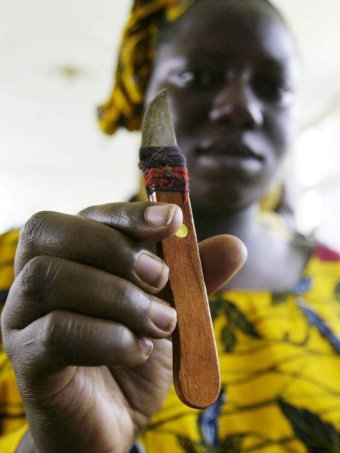Human Rights of Women
Source: ABC
The United Nations children's fund, UNICEF, says more than 125 million girls and women have undergone female genital mutilation, and 30 million more are at risk in the next decade.
The UNICEF report is based on surveys in 29 countries across Africa and the Middle East over the past 20 years.
The report reveals that in most of those countries, girls are less likely to be cut today than their mothers, and that the lowering of that risk is linked to higher education levels.
 The tradition involves removal of some or all of a female's external genitalia, and can include cutting out the clitoris and sometimes sewing together the labia.
The tradition involves removal of some or all of a female's external genitalia, and can include cutting out the clitoris and sometimes sewing together the labia.
Laws are not enough to stop the practice entirely, and more people must speak out in order to eliminate it among certain ethnic groups and communities, the researchers said.
The tradition remains "remarkably persistent, despite nearly a century of attempts to eliminate it," it said.
"As many as 30 million girls are at risk of being cut over the next decade if current trends persist."
The practice "is becoming less common in slightly more than half of the 29 countries studied," said the report, noting that "overall support for the practice is declining."
The ritual is practiced by various faiths, including Christians, Muslims and followers of African traditional religions.
Some believe it improves a girl's marriage prospects, or that it is more aesthetically pleasing.
The highest mutilation rates are in Somalia
The report says genital mutilation is "almost universal" in some countries.
It found the highest rates in Somalia, where 98 per cent of females aged 15-49 have been cut, followed by 96 per cent in Guinea, 93 per cent in Djibouti, and 91 per cent in Egypt.
It said there was no discernible decline in countries such as Chad, Gambia, Mali, Senegal, Sudan or Yemen.
The amount of data for analysis varied from country to country, but declines were apparent over time in countries like Kenya and Tanzania, where women in their 40s were three times as likely to have undergone cutting as girls 15-19.
Prevalence of genital cutting among teenage girls has dropped by about half in Benin, the Central African Republic, Iraq, Liberia and Nigeria.
The report found that even though the genital cutting is often considered a form of patriarchal control, there is a similar level of support among men and women for stopping it.
Mutilation is still socially acceptable, despite opposition
"Social acceptance is the most frequently mentioned reason for supporting the continuation of the practice," said report author Claudia Cappa, a UNICEF statistics specialist.
"This is the main reason why women - mothers - still have their daughters cut. And this is done sometimes even if they think the practice should be discontinued," she told reporters in Washington.
Ms Cappa said that research showed that "many boys and men also want this practice to end, and this number is growing."
Last year the UN General Assembly adopted a non-binding resolution to intensify global efforts to eliminate female genital mutilation.
Francesca Moneti, UNICEF senior child protection specialist, said generations of tradition could be difficult to overcome.
"It is something that has just always been there," she said.
"You need to have a moment of discussion where people can come out and say that they don't support it."
